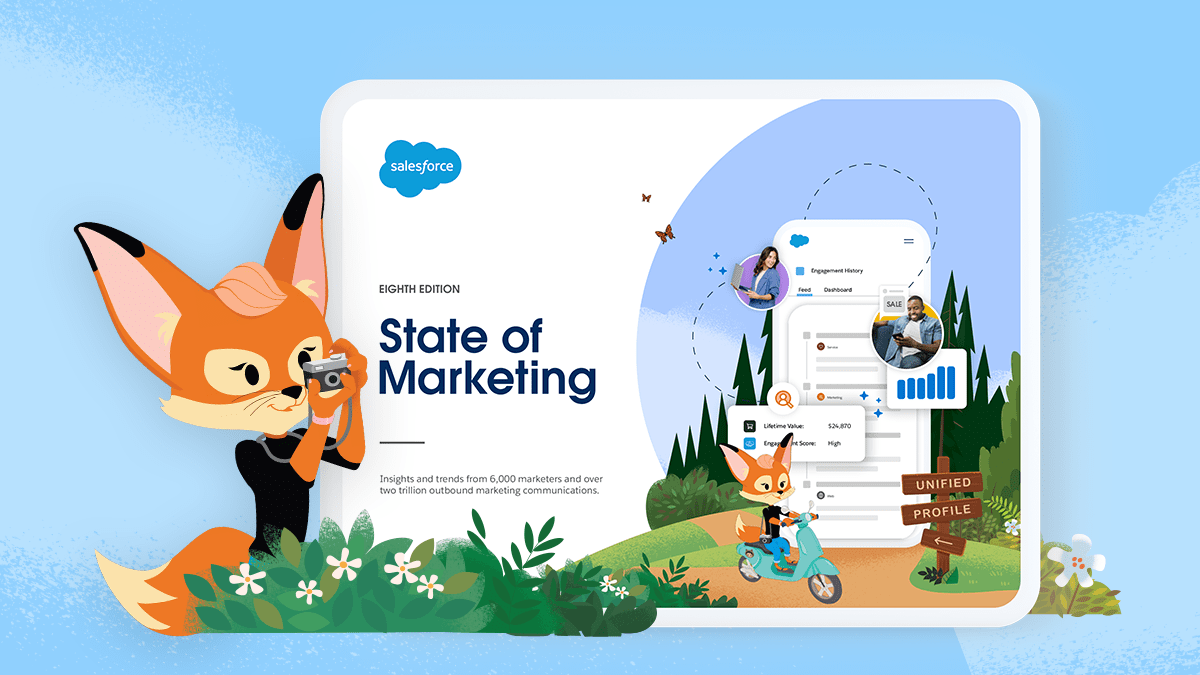How to Use AI to Transform Your Email Marketing

Adopting AI in email marketing can help improve open rates, increase results, and support A/B test runs. Here’s how.
The past few years have brought new ways for marketers to connect with customers, but email is still a powerful way to engage. In fact, customers say email still is their preferred channel to interact with brands. According to our research, the number of outbound emails increased 15% last year. The volume of sends is high because it’s driven by high customer engagement. And now AI in email marketing is helping to boost results even more.
AI is helping us in many ways, but it’s still in the early stages. There are plenty of questions that marketers need to answer before fully taking advantage of the technology. How do we integrate AI into our strategy? How will AI work with our existing platform? How will we know AI will target customers the way we want?
Read on for tips on how AI can help your email marketing, from generating messages to optimising their performance.
- What is AI in email marketing?
- How can AI in email marketing increase performance?
- What are the challenges with AI in email marketing?
- How can AI help with my email content?
- How does AI in email marketing improve ROI over time?
- What are the best practices for using AI in email marketing?
- What’s ahead for AI email marketing
The 8th Edition State of Marketing Report
Discover insights on changing trends, priorities, innovative technology like AI, and challenges defining the profession, according to 6,000 global marketers and trillions of outbound marketing messages.

What is AI in email marketing?
AI in email marketing uses machine learning algorithms to personalise content, optimise send times, and segment audiences.
While predictive AI provides insights based on historical data, generative AI can use this information to create new, relevant content or solutions that are tailored to specific user needs at speed and scale. They work together to automate, optimise, and personalise the email marketing process. Both have the same goal: improved email marketing engagement and customer satisfaction.
AI — which is embedded into many marketing platforms — can help you optimise and deliver great email marketing campaigns, as long as you understand how the technology works. For example, by analysing a customer’s response to various email campaigns and website interactions, AI can assign a lead score that indicates the likelihood of conversion.
AI can also provide insights into the potential revenue generated by each customer over their lifetime with the brand. You can also prompt AI to generate profiles of ‘lookalike‘ audiences, enabling you to expand your reach to new prospects who are more likely to engage and convert.
How can AI in email marketing increase performance?
One marketer recently told us that generative AI is where “creativity meets innovation and personalisation takes centre stage.” It’s clear that they’ve tapped into its ability to create natural language-based segments for more nuanced messaging.
As customers’ preferred communication patterns are identified, you can segment customers to deliver highly personalised and targeted content at scale. By using AI, you increase your chances to understand and represent your customer’s preferences. In doing so, AI not only enhances customer experiences but also makes them inclusive, ensuring a diverse range of customer preferences are represented.
With its ability to analyse historical customer engagement patterns – such as open rates, click-through rates, and conversion rates – predictive AI can identify the best moments to send emails to individual recipients. Subscribers receive emails according to their preferences, which minimises email fatigue and enhances engagement and loyalty.
This brings us to email A/B testing, the strategy where you provide different email versions to your audience to help you figure out which variation performs better. The responses readers take are clear-cut, meaning they choose between two-option reactions or actions, such as opening or not opening an email.
When you use AI to test email subject lines, you can find out which one generates higher engagement rates. You’ll also maximise clickthrough rates which will help you fine-tune your messaging – keeping in mind the goal of discovering what works best for a given audience.
One marketer reported how their A/B testing improved 10x using generative AI in email marketing.
“Instead of testing only subject lines, I can also test user behaviour, allowing me to be more strategic with every send,” they told us. “Along with content, I also use AI in the design process. It helps me select images and colours that best resonate with my target audience.”
AI helps get the low-expertise structure done so you can add the high-value content and your specified point of view. For example, you can ask it for a list of subcategories and their definitions for a topic you’re exploring.
What are the challenges with AI in email marketing?
As you adopt and adapt AI, you’ll see benefits like increased personalisation at scale, improved engagement, and reduced costs. However, there could be undesirable consequences if you don’t grasp the fundamentals.
Safeguards must be in place to make sure AI programs are learning fast enough to keep up with changing customer behaviour.
- Ethical concerns about data privacy, security, and consumer trust call for compliance and regulations to keep customer information safe.
- Technical expertise is vital for successful AI integration, so training up to an AI-skilled workforce capable of optimising tools and platforms can feel like a major hurdle.
Good AI in email marketing relies on a solid data foundation. It also relies on making the outputs of AI usable in the flow of work. What data streams can you realistically plug into your AI email marketing efforts?
How can AI help with my email content?
AI can improve your email content by helping with personalised messaging. A marketer for a clothing retailer, for example, can create one email that showcases product recommendations based on purchases and browsing behaviour. The marketer can then prompt AI to quickly create ten new versions of that original email with the intention of catering to different customer segments.
Now that you have all that email content, you can use it to create one-to-one personalisation. Keep in mind that your AI strategy should be connected to your data and customer engagement strategy for best results. You can use the historical data from your customer relationship management (CRM) system to integrate dynamic content, offers, and recommendations for individual customers.
Based on how your customer interacts, AI can then power the next best email to continue the journey. Your AI-powered email content now understands your specific customer preferences and business goals, making it easier for you to tailor your messaging.
This type of content creation simultaneously streamlines and scales the process of customisation.
How does AI in email marketing improve ROI over time?
AI models are trained to deliver insights from every customer interaction. Their algorithms continuously adapt and learn with each interaction, so you’re able to get better results from your A/B email testing.
AI analytics can help you reach across your entire email dataset – or, as it’s more commonly known to do now, bring in data from other sources in your customer data platform (CDP). It works by combining customer interactions across email, website, and purchases – analysing preferences and trends.
With your customer base’s specific patterns, tendencies, and connections identified, you’re that much closer to being able to segment them. It’s easier to target communication with segmented audiences.
AI-powered dynamic content can enhance customer engagement – surging the potential for click-through rates. By tailoring email content to customer preferences, including product recommendations and offers based on data, AI helps to make sure that emails resonate with the recipient. It can save you thousands of hours and result in conversions.
What are the best practices for using AI in email marketing?
There’s no doubt AI email marketing is the wave of the future. Here are some AI fundamentals you can’t afford to skip:
Start with building an ethical, strategic, and technological foundation. This means implementing transparent data practices, ensuring data privacy compliance, and fostering a culture of ethical AI usage internally.
It also means establishing clear goals and plans for how you want to apply new AI advances. Having a roadmap for what you wish to accomplish should always be the first part of the plan.
A few other tips:
- Use embedded, no-code AI features like send-time optimisation, content selection, and subject line testing. Work up to creating multi-variant emails allowing for diverse content versions catered to specific customer segments.
- Move into the realm of real-time personalisation, tailoring email content in response to immediate customer behaviours and preferences. Then explore the intricacies of building custom AI models tailored to your unique business needs.
- Start with your email data as a foundation. Grow your customer profiles using a fuller picture of each customer across marketing, sales, commerce, and service. The customer insights you get from integrating data into a CDP will help you create more personalised emails.
- Apply what you know about AI capabilities for personalisation to segment your audience.
- Learn how to creatively prompt AI to generate fresh content.
- When you do your A/B email testing, don’t test multiple things at once. It’s important to make sure you have a control group. Leading AI email marketing platforms have tools to automate this process so you can test continuously.
- Employ a system for analytics, iteration, and retargeting. This system should be able to connect your email performance to web and app conversions as well as commerce and sales data to optimise business impact. This is a key requirement to look for in your AI email marketing software.
What’s ahead for AI email marketing
AI is the key to making sure people open and read your emails. From creating content to testing performance, AI can help identify the best ways to improve your email campaign.
AI is transforming the entire marketing workflow. For all its newness, there are plenty of lingering questions about how AI email marketing will improve and what new capabilities marketers can expect to see.
Think about AI as a combination of a supportive friend and personal assistant — a tool that helps you put your big-picture goals in focus.
AI can help test your email send times and content selection, including catchy subject lines, images, and colours. It can take the guesswork out of how to connect with your customers by helping deliver personalisation at scale.
AI can help you move faster. Right now, pushing out more content is a lengthy process that requires multiple layers of approval. With AI at your side, it’s likely we will see a real decrease in turnaround time.
In addition to automating manual tasks, AI will continue to help drive marketers toward more empathetic and thoughtful content. In this sense, AI can help you be more efficient and become better at what you do.
These days, marketers are more focused on first-party data — information gained directly from the customer. Instead of relying on old systems like open-data exchanges to buy audience data, they are modernising the way they build first-party data assets through the lens of user consent. Using AI in email marketing is essential for acquiring that precious data. As data and AI become more integrated, the growing importance of trust in email cannot be over-emphasised.
We’re also seeing a reimagining of the creative process, with generative AI reaching a point where it can create 1:1 personalisation for every email – and not just for customer segments.
In the next two to five years, marketers using AI will be furthering businesses to make better decisions in their email marketing campaigns. Most of the campaign process, from lead generation to final customer message, will be led by marketers with strong knowledge of how AI works.
Start sending better emails today
Want to grow and engage your audience through email? Check out the interactive elements available to you within Marketing Cloud and start sending emails your customers will love.





























